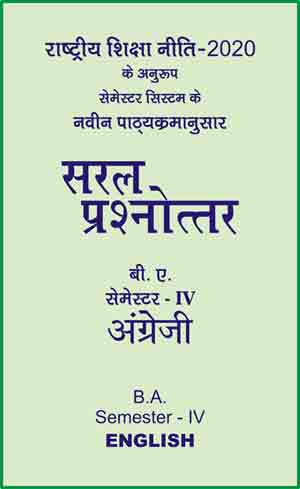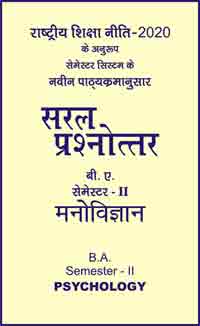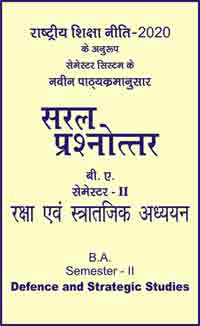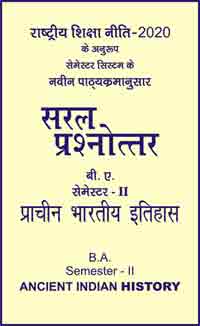|
बी ए - एम ए >> बीए सेमेस्टर-4 अंग्रेजी बीए सेमेस्टर-4 अंग्रेजीसरल प्रश्नोत्तर समूह
|
5 पाठक हैं |
|||||||
बीए सेमेस्टर-4 अंग्रेजी - सरल प्रश्नोत्तर
Unit-III: Fiction
Chapter - 4
Rabindranth Tagore, The Home and the World
: Tr. Surendranath Tagore
Brief Introduction
The story begins with Bimala describing her relationship with Nikhil. She practically worships Nikhil, but she despises her sister-in-law, who often teases and insults her. Nikhil turns a blind eye to his sister's treatment of Bimala. Rather, Nikhil wishes Bimala would see herself and him as equals and leave the home together occasionally. Nikhil is loosely involved in the Swadeshi movement, often funding various projects to help the local economy. In addition, he funds Sandip Babu, an Indian nationalist speaker whom Bimala- suspects of taking advantage of her husband.
Bimala and Nikhil see Sandip speak, and she is deeply moved by his charisma. Sandip stays with Bimala and Nikhil, and during dinner, he and Nikhil argue about the extent to which nationalism will help India. Bimala, in an unusual display of autonomy, sides with Sandip and disagrees with her husband, believing that movements must sometimes be informed by passions rather than temperance. Sandip compliments Bimala throughout the night and believes that she is the embodiment of India. After another argument with a similar outcome, Nikhil feels that he is becoming inadequate for his wife. Nikhil's former school master and friend, Chandranath, arrives and encourages Nikhil to send Sandip away, but Sandip decides that Nikhil's estate is the perfect place to do his business. Furthermore, he wants Bimala to be his Shakti, a woman to represent the Indian people.
Sandip considers how he will continue to manipulate and use Bimala, and he regularly meets with her in the sitting room to ask her advice. One day, he is stopped by a guard from entering the sitting room. The guard had been ordered by Rani to keep Sandip from entering. Sandip punches the guard to get through, and Bimala insists that the guard be fired, but Nikhil just assigns him to another part of the estate. Later, Sandip walks in on Bimala reading a book about sexuality, which greatly embarrasses her. He pretends not to notice, but when Nikhil comes into the room, Sandip says that Nikhil needs to read it and further attempts to make Nikhil uncomfortable by suggesting Bimala read it, although this does not upset Nikhil.
Bimala becomes more and more attracted to Sandip. She resolves to give herself over to him, but when they are together, her maid comes into the room, demanding pay and vowing to quit. Rani's servant had insulted Bimala's maid. Bimala confronts Rani and is reprimanded, which enrages Bimala beyond words. She goes back to her room where she sees keepsakes that remind her of Nikhil and falls, sobbing. Meanwhile, Sandip is concerned that he is becoming too soft, and he commits to the idea of sexually taking Bimala to assert his dominance.
As the Swadeshi movement gains momentum, the importation of European-made goods comes to be looked down on by the public. Nikhil sees that Bimala is slipping away, and for both their sakes, he believes he needs to free her from himself. He remembers when Panchu, a poor man, came to his house to repay coconuts that he had stolen from the estate years before. While Nikhil's reaction was to change the system that made Panchu poor in the first place, Bimala's concern was with their own security and wealth. This memory serves to show how different Bimala and Nikhil are ideologically.
Nationalist students who have returned for the summer and joined Sandip's cause argue with Nikhil about the foreign goods being sold in his market, but he refuses to place sanctions against his vendors. Meanwhile, Panchu's wife dies of a disease, and he must purify himself with the Brahmins but does not have the money to do so. He leaves to wander the lands while Chandranath looks after his children. Panchu returns, and Chandranath offers him a loan, but eventually Panchu is evicted and made to burn his possessions for selling found foreign-made goods for extra money Nikhil offers to buy up some land and let Panchu stay there, but Panchu is concerned there will be more demonstrations against him.
Important Facts to Remember
The first book our club discussed in June was the compelling The Home and the World (1916) by Rabindranath Tagore, a Bengali writer, musician, and artist.
Tagore received the Nobel Prize in Literature in 1913 and shaped the Eastern viewpoint on nationalism and Indian culture. He also spent some time at our university and even though he hadn't graduated at UCL (not a direct result of a pandemic as it is the case today), his studies didn't escape our discussions and comments on him and other prominent "episodic" students of London universities.
His novel is often considered to be a part of the Indian literary canon, yet we tried to praise as well as criticise Tagore's genius. The Home and the World is the novel of the senses, and all of us agreed on his sensory and natural imagery being one of the best features of the novel, together with the novel's interesting collaboration of the narrators, contentious philosophical discourse, and poetic language (similarities made between Tagore the writer and Tagore the painter). Adversely to this, worth mentioning was his most influential critic, György Lukács, who considered him tedious and unimaginative and this novel as a mere one-sided propagandistic pamphlet.
The story is set in India and follows the contemporary nationalist movements, the emphasis given to the problems of the colonial powers in the market, the morality behind violence, and the unfathomable question of 'What does it mean to me to be a part of a nation? Tagore's philosophy encouraged a healthy relationship with one's nation, neither denying one's culture nor following it blindly. He believed solely in the power of individual freedom (not national and especially not national in the Western sense) and opposed the pre-Gandhian Swadeshi Movement and even Gandhi himself (who supposedly also studied at UCL).
The three main characters work together to convey the story, each having various confessions throughout the novel.
Nikhil, a peace-loving Indian noble, whose opinions coincide with those of Tagore, wants the best for his family and community (which could be understood as the nation in this context) but refuses to use violence or patriotic incitement in his fight for independence, because "To tyrannize for the country is to tyrannize over the country."
Sandip, his childhood friend of a lower caste resides for the time in his house and is considered the "Enlightened" leader of the Bande Mataram national movement. The narrative uncovers his great enthusiasm for having power and money, being a rowdy revolutionary, in the spirit of "We shall want all we can get." Nonetheless, our discussions also took into consideration if his actions, despite being immoral, were in any way justifiable.
Bimala is Nikhil's wife, who got attracted to Sandip's charisma and rhetoric (comparisons with the enchanting force of the magic mountain of the same-titled novel of two weeks ago are welcome). Previously considered ugly and ordinary, in Sandip's eyes, Bimala suddenly became a beautiful muse; a goddess, though ungodly, and a mother, though childless.
Rabindranath Tagore's The Home and the World (1915) is usually read in terms of an allegory, either on the historical event of partition of Bengal in 1905 or on the nationalist worship of Mother India around the turn of the twentieth century. Such allegorical readings are possible for obvious reasons: the novel is set at the time of the Swadeshi movement, which emerged as the radicallyadministration, at a time when "Bande Mataram (a song composed by Tagore's senior contemporary in Bengali literature, Bankim Chandra Chattopadhyay) had become a much used rallying cry among the nationalists. The Home and the World challenges the notion of India as an exclusive Hindu nation. It questions the validity of a nationalism that focuses on emotion rather than on economic selfsufficiency and social justice. It takes exception to the aggressive masculinity of the nationalist project.
As an intense literary text, The Home and the World could be read in yet other ways, in terms of other allegories. This paper offers an alternative reading, inspired by comparing the novel with early twentieth century Vietnamese novels. The Home and the World is a novel that reads like an allegory on the failure of the Indian nationalist projects, circling around the issues of "Home" versus "World," tradition versus modernity, created by the active involvement of the colonisers in the cultural, economic and administrative life of the colonised. It could be read as an allegory on the failure of Indian nationalism to accept tradition and modernity, home and the world, together. In addition, the novel offers an alternative nationalist project that could free India from its obsession with the colonising powers: true freedom of the nationalist imagination will be gained by going beyond every form of ideological prejudice and separation and by synthesising every conceivable value that could be useful for the development and maintenance of the nation. And as a concrete implementation of his alternative nationalist project, Tagore founded Visva Bharati University in Santiniketan in 1921.
The Home and the World was published ten yea after the vexing partition of Bengal and the beginning of the magic incantation of "Bande Mataram, first in Bengali (1915), and then in English (1919). The Swadeshi movement, which emerged in the wake of the Partition, did not only mobilise Bengal but also spread throughout India as the "beginning of a truly national movement and a struggle between the men and methods that were to lead it" (Rege 39). "Bande Mataram" (Hail to Thee Mother) became the "war cry" of the opposition against the Partition; just like the Swadeshi movement, it spread "over the entire subcontinent" (Iyengar 366). Conflicts within the Indian Congress about the role and function of Swadeshi led to divisions within the movement: the extremists adopted the Swadeshi, claiming the superiority of the Indian economy, politics and arts while the moderates wanted to dedicate themselves to social reform. After a decade of challenging and fighting each other, the conflicting nationalist projects seemed to be neutralised when the so-called 1917 Declaration made India a more directly ruled colony in terms of administration and economy. However, once Mahatma Gandhi gained control over the Indian National Congress in the early 1920s, the movement of non-cooperation gained strong footholds all over India again; the ideas of Swadeshi were revived; the economic system was reorganised; and government schools and colleges were boycotted.
Indian nationalist projects in the late nineteenth and the early twentieth century revolved around the issue of "Home" versus "World," tradition versus modernity, culture (humanities) versus technology. Prior to 1885, Indian intellectuals thought that the imitation of British ideas about society and culture should lead to a better, more correct India. After 1885, resistance grew against colonial involvements in the cultural dynamics of India, and more than that, the Home - Indian culture - was thought to be sovereign from the "the West" and should keep a distance from Western control. In the domain of modernity, the World, India "... has no option but to choose its form from the gallery of 'models' offered by European and American nation-states"
The Home and the World could be read as a representation of the nationalist projects that were formulated around the "Home" and the "World" in late nineteenth century in India. The novel's main female character, Bimala, performs the role as a conveyor of such a project.
In practice, the nationalist projects of the Home and the World are meant to be alternatives to the colonialist project of culture. It is the British policy to barbarise Indian culture and decorate it with Western techniques and modernity and this is the policy that shapes the emergence of the Home and the World's projects (Chatterjee10-13). Those who carry these nationalist projects are the colonial middle class in Calcutta, economically and politically dominated by the British colonial elite: the subordination of the middle class of Calcutta to the colonial system "was to be premised upon its cultural leadership of the indigenous colonized people" (Chatterjee 36) an ambivalent position, of subordination and of dominance.
In The Home and the World, women fail in making their voice heard and their body seen in the process of nation building. Cultural terms such as "modern," "old tradition" and "I have been educated and introduced to the modern age in its own language"; economic terms such as "bank," "the rate of interest," "political economy" and "industries"; and political terms such as "enemy," the "world" and "the home," seem to evoke a raw mixture of notions that Bimala's mind is unable to digest.
Tagore chose Bengal as the setting for his novel16 not only because Bengal was his home, but also because it was the centre of the colonial administration which, in 1905, initiated the so-called Act of Partition, dividing Bengal into a Muslim part and a Hindu part. This division was to create hate and distrust between the two parts - and hate and distrust have lasted until the present day, becoming one of the traumas of Indian nationalisms. It is this colonial legacy which frustrates the nationalisms that are invoked in The Home and the World; building the Home - tradition, morality, culture or developing the World - the West, modernity, technology, economy, administration: the nationalist projects of the Home and the World were bound to fail, due to lasting colonialist involvement with nationalisms as much as, conversely, the nationalist obsession with the colonizer.
The two main male characters, Nikhil and Sandip, fusion as two possibilities of The Home and the World's nationalist projects; they act as core agents of the World by offering utopianism and rationalism, respectively. Whereas the mixed voice of Bimala presents the lack of wisdom and freedom of the colonised mind, the voices of the myth-breaking Sandip and the utopian. Nikhil suggest the unfeasibility of both rationalist nationalism and utopian nationalism. Whereas Sandip bases his nationalism on an extremist belief in individual wisdom, science and passion, Nikhil devotes his life to the ultimate truth, a complete freedom of mind and voice. These imaginations, however, cannot unlock themselves from colonial knowledge and the "traditions" of India.
Tagore's description here parodies the discourses of the late Nineteenth Century nationalist project of the mythical model Ramakrishna who helped to evoke the belief in the nation: the East finds its dictatorship in the spiritual domain, which the West is unable to reach. In the parody-like portrayal of Sandip, Tagore challenges the belief that India can build a pure culture based on myths of "the Indian tradition" alone.
It is tragic that the rhetoric calling for freedom of the mind is full of terms of colonial knowledge: "country, "police," "freedom, " "manhood, "trade," "will," etc. Nikhil's concept of the "frantic" and "desire” remains vague and abstract; it is not attached to any subject or agent. As he does not give an explanation of how the individual desire functions in the imagined nation, his concept tends to be of psychological rather than of political character, and the fact that he eventually gets injured should be read as symbolic for the failure of his utopian desire for cooperation between Muslims and Hindus.
The novel The Home and the World does not offer a concrete form of "the nation" but only a possibility. This imaginative alternative, as suggested, might be the model that makes colonised India come closer to its colonisers, to understand them, to "curse" them (Jose 21), and to call for their support in implementing national projects. Tagore was actively involved in the translation of his novel The Home and the World and of his other works into English, and he tried to use Western concepts and explain Indian concepts by way of Western concepts. He might have been aware of the range of possibilities of "the nation" that are available for the colonised. In the particular case of The Home and the World, Tagore translated the novel about "the nation" alongside his calls for support and help from Europe for his project of an international university, Visva Bharati. Visva Bharati, he imagined, was to be the embodiment of a future India as a harmonious unity of West and East.
The Home and the World as a novel about the colonisation of the market and country, describing an individual's difficult relationship between one's immediate neighbourhood and more widely, the whole world. While some of us saw the character of Nikhil in a positive light and his libertarian stance as progressive, others considered it as negative, since his actions made him an ally of the colonising powers. Power, however, was regarded differently by Sandip, who thought becoming exactly like the "all-powerful" world is the only way to save his home: "The greatest weapon of those who rule the world, Sandip Babu has told us, is the hypnotism of their display. To take the vow of poverty would be for them not merely a penance - it would mean suicide.
The Home and the World as the gender struggle. As mentioned before, the novel handled the subject of the position and responsibility of men and women, which varied, depending on the domestic and cosmopolitan environment they occupied. Additionally, the status of a housewife was re-evaluated throughout the story. "What is a wife? A bubble of a name blown big with your own breath, so carefully guarded night and day, yet ready to burst at any pin-prick from outside.'
The Home and the World as a story about violence. In times of revolution, Nikhil's house served as a safety net against the turmoil on the outside. Bandits getting in and robberies happening challenged the security a home should possess. Especially, since Bimala was the one responsible: "I could not think of my house as separate from my country: I had robbed my house, I had robbed my country. For this sin my house had ceased to be mine, my country also was estranged from me." More generally, however, Nikhil's wealthy mansion was much safer in the revolution-driven India than, for example, the property of his servant Panchu, which was in danger. Tagore wrote novels, short stories, poems, essays, verses, dramas, songs, and a lot of other stuff. He is believed to have worked on almost all kinds of genres.
Tagore is said to have composed over 2000 songs and his songs and music are called 'Rabindra Sangeet' with its own distinct lyrical and fluid style.
Tagore is responsible for modernising Bengali prose and poetry. His notable works include Gitanjali, Ghare-Baire, Gora, Manasi, Balaka, Sonar Tori, He is also remembered for his song 'Ekla Chalo Re'.
Tagore published his first poems aged 16 under the pen-name 'Bhanusimha'.
Tagore not only gave the national anthems for two countries, India and Bangladesh, but also inspired a Ceylonese student of his, to pen and compose the national anthem of Sri Lanka.
Besides all his literary achievements he was also a philosopher and educationist who in 1921 established the Vishwa-Bharati University, a university that challenged conventional education.
In 1913 Tagore was awarded the Novel Prize in Literature for his work on Gitanjali.
Tagore was the first non-European to receive the Nobel Prize.
In 1915 Tagore was awarded knighthood by the British King George V. In 1919, following the Jallianwalla Bagh massacre, he renounced his Knighthood.
|
|||||














